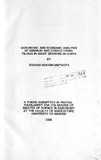| dc.contributor.author | Mutuota,JM | |
| dc.date.accessioned | 2013-05-23T09:47:42Z | |
| dc.date.available | 2013-05-23T09:47:42Z | |
| dc.date.issued | 1988 | |
| dc.identifier.citation | Degree Of Master Of Science In Agronomy, University of Nairobi, 1988 | en |
| dc.identifier.uri | http://erepository.uonbi.ac.ke:8080/xmlui/handle/123456789/24784 | |
| dc.description.abstract | Farmers spend a lot of time every year in Kenya in seed-bed preparation and weeding for maize. Late planting and poor weed control are among the major causes leading to low grain yields in many small-scale farms This study was carried out to compare
the economic and agronomic analyses of conventional tillage and minimum tillage systems. Glyphosate at a rate of 2.5 Kg a.i. per hectare and paraquat at a rate of 1.0 Kg a.i. per hectare were applied as post-emergence herbicides in the minimum
tillage plots. In this tillage system furrows and spots were opened for seed and fertilizer placement. In conventional tillage a hoe was used to prepare the whole seed bed.
Conventional tillage took more time than minimum tillage during seed-bed preparation. During the short rains, weeding in conventional tillage took less time than in minimum tillage.
There was no significant difference (P=0.05) in yields between the minimum and conventional tillage treatments. paraquat application was the most economical method of seed-bed preparation followed by conventional tillage. Paraquat application
was the most economical method of seed-bed preparation followed by conventional tillage. The most expensive method was in minimum tillage where glyphosate was
used. Although less time was used in minimum tillage in spraying the herbicides and digging furrows than in conventional tillage where the whole area was dug clean with a
hoe to prepare the seed-bed, the cost of glyphosate herbicide was very high. Glyphosate was more expensive than paraquat.
This made minimum tillage treatments where glyphosate was used the most expensive. conventional tillage method required significantly less labour (P=O.05) during weeding than minimum tillage, therefore cheaper than minimum tillage. The only advantage in minimum tillage was during the first weeding because labour was spread over a longer period i.e. by first having intra-row weeding which removed weeds from the plants, followed by inter-row weeding where the weeds were cut at ground level using a panga. | en |
| dc.language.iso | en | en |
| dc.publisher | University of Nairobi | en |
| dc.title | Agronomic and economic analysis of Minimum and Convectional Tillage in Maize growing in Kenya | en |
| dc.type | Thesis | en |
| local.publisher | Faculty Of Agriculture | en |

